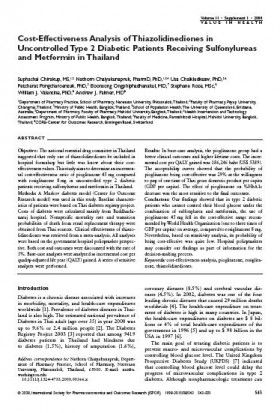This website uses cookies so that we can provide you with the best user experience possible. Cookie information is stored in your browser and performs functions such as recognising you when you return to our website and helping our team to understand which sections of the website you find most interesting and useful.
Cost-Effectiveness Analysis of Thiazolidinediones in Uncontrolled Type 2 Diabetic Patients Receiving Sulfonylureas and Metformin in Thailand (2008)

รายละเอียดเพิ่มเติม
Cost-Effectiveness Analysis of Thiazolidinediones in Uncontrolled Type 2 Diabetic Patients Receiving Sulfonylureas and Metformin in Thailand.
Suphachai Chirakup1,2 Nathorn Chaiyakunapruk1,3,4 Usa Chaikledkeaw5,6 Petcharat Pongcharoensuk5 Boonsong Ongphiphadhanakul7 Stephane Roze8 William J. Valentine8 Andrew J. Palmer8
1Department of Pharmacy Practice, School of Pharmacy, Naresuan University, Phitsanulok, Thailand;
2Faculty of Pharmacy, Payup University, Chiangmai,Thailand;
3Ministry of Public Health, Bangkok,Thailand;
4School of Population Health,The University of Queensland, Brisbane, Australia;
5Department of Pharmacy, Faculty of Pharmacy, Mahidol University, Bangkok, Thailand;
6Health Intervention and Technology Assessment Program, Ministry of Public Health, Bangkok,Thailand;
7Faculty of Medicine, Ramathibodi Hospital, Mahidol University, Bangkok, Thailand;
8CORE-Center for Outcomes Research, Binningen/Basel, Switzerland
Objective
The national essential drug committee in Thailand suggested that only one of thiazolidinediones be included in hospital formulary but little was know about their costeffectiveness values. This study aims to determine an incremental cost-effectiveness ratio of pioglitazone 45 mg compared with rosiglitazone 8 mg in uncontrolled type 2 diabetic patients receiving sulfonylureas and metformin in Thailand.
Methods
A Markov diabetes model (Center for Outcome Research model) was used in this study. Baseline characteristics of patients were based on Thai diabetes registry project. Costs of diabetes were calculated mainly from Buddhachinaraj hospital. Nonspecific mortality rate and transition probabilities of death from renal replacement therapy were obtained from Thai sources. Clinical effectiveness of thiazolidinediones was retrieved from a meta-analysis. All analyses were based on the government hospital policymaker perspective. Both cost and outcomes were discounted with the rate of 3%. Base-case analyses were analyzed as incremental cost per quality-adjusted life year (QALY) gained.A series of sensitive analyses were performed.
Results
In base-case analysis, the pioglitazone group had a better clinical outcomes and higher lifetime costs. The incremental cost per QALY gained was 186,246 baht (US$ 5389). The acceptability curves showed that the probability of pioglitazone being cost-effective was 29% at the willingness to pay of one time of Thai gross domestic product per capita (GDP per capita). The effect of pioglitazone on %HbA1c decrease was the most sensitive to the final outcomes.
Conclusions
Our findings showed that in type 2 diabetic patients who cannot control their blood glucose under the combination of sulfonylurea and metformin, the use of pioglitazone 45 mg fell in the cost-effective range recommended by World Health Organization (one to three times of GDP per capita) on average, compared to rosiglitazone 8 mg. Nevertheless, based on sensitivity analysis, its probability of being cost-effective was quite low. Hospital policymakers may consider our findings as part of information for the decision-making process. Keywords: cost-effectiveness analysis, pioglitazone, rosiglitazone, thiazolidinediones.
Link:




